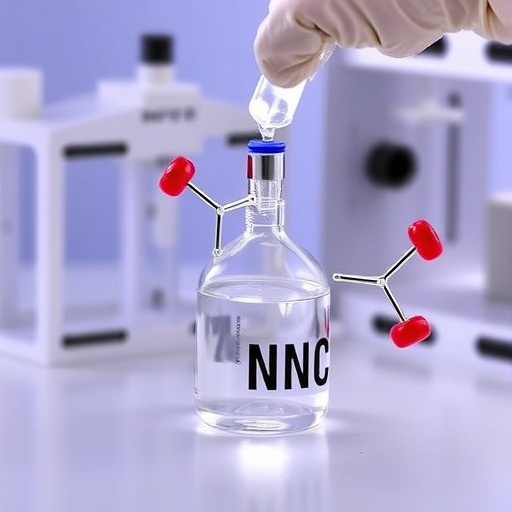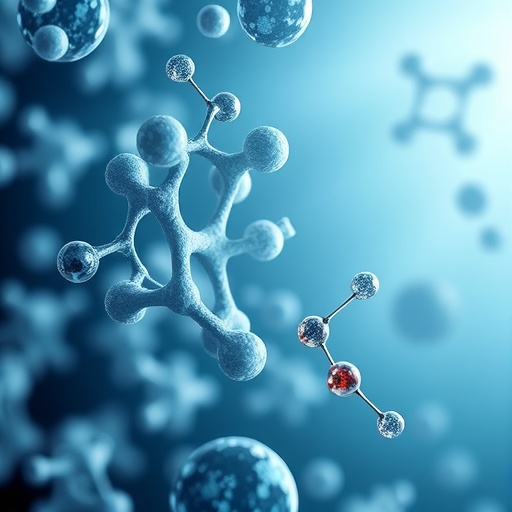In the ever-evolving domain of synthetic chemistry, the exploration of efficient and safer methodologies to transform bioactive molecules remains central to advancing pharmaceutical and material sciences. A recent breakthrough reported by Tu, Xiao, Chen, and colleagues heralds a transformative leap in how aromatic amines—ubiquitous functional groups in medicinal chemistry—are modified into other diverse functionalities. This new approach circumvents the long-standing challenges associated with classical diazonium salt intermediates, offering unparalleled operational simplicity and significantly enhanced safety profiles.
Amines serve as foundational building blocks across a vast spectrum of bioactive compounds, underpinning pharmaceuticals, agrochemicals, and organic materials. Despite their prevalence, the chemical transformation of aromatic amines, particularly the cleavage and substitution of the aromatic C–N bond, has traditionally hinged on forming diazonium salts. Although effective, diazonium intermediates are notoriously unstable and pose severe explosion risks, complicating their practical application and scalability in both academic and industrial settings.
Addressing these longstanding limitations, the research team has introduced a direct deaminative functionalization strategy employing N-nitroamines as pivotal intermediates. This innovative pathway enables chemists to bypass the hazardous diazonium salts entirely, directly converting relatively inert aromatic C–N bonds into a remarkable variety of carbon–heteroatom and carbon–carbon linkages. The spectrum of accessible products now includes C–Br, C–Cl, C–I, C–F, C–N, C–S, C–Se, C–O, and various C–C bonds, markedly expanding synthetic versatility under mild and operationally straightforward conditions.
One of the most compelling features of this approach lies in the unification of cross-coupling methodologies, whereby the formation of N-nitroamines seamlessly integrates with transition-metal-catalyzed arylation reactions within a single synthetic operation. This one-pot strategy not only economizes time and resources but also simplifies complex synthetic routes, a boon for late-stage functionalization where subtle molecular modifications can have profound effects on biological activity and material properties.
The robustness of this new method is demonstrated across an astonishingly broad chemical landscape. It efficiently modifies a wide array of medicinally relevant heteroaromatic amines and structurally diverse aniline derivatives. Importantly, the process proves largely indifferent to the electronic nature of the substrates and the specific positioning of the amino group on the aromatic ring, underscoring its generality and potential to revolutionize functionalization approaches for complex molecules.
Mechanistic insights gleaned from complementary experimental observations and computational analyses reveal that the reactivity of the N-nitroamine intermediates is best rationalized through an aryl cation equivalent paradigm. This electrophilic character enables the intermediates to act as versatile synthetically useful intermediates under mild conditions, facilitating substitution pathways that have traditionally been challenging under conventional diazonium chemistry.
From a safety perspective, the transition away from explosive aryldiazonium salts represents a paradigm shift within synthetic organic chemistry. The newfound stability and ease of handling associated with N-nitroamines reduce the inherent risks of traditional protocols, fostering safer laboratory environments and facilitating scale-up operations in industrial synthetic processes. This advance harmonizes the oft-conflicting priorities of synthetic efficiency, operational safety, and environmental consideration.
The researchers also highlight the synthetic applications that stand to benefit immensely from this technology. Late-stage functionalization—a critical step in drug development and lead optimization—can now be performed with greater confidence and flexibility, enabling fine-tuning of physicochemical and pharmacokinetic properties without compromising molecular integrity. This could accelerate the discovery pipeline and diversify the chemical space explored in medicinal chemistry campaigns.
Furthermore, the implementation of this method in constructing complex carbon–heteroatom linkages aligns with the growing importance of heteroatoms in imparting resilience, bioavailability, and specificity to therapeutic agents. The ability to selectively incorporate halogens or chalcogens into aromatic scaffolds improves binding interactions, modifies metabolic profiles, and enables downstream synthetic elaborations that are crucial to drug design.
In addition to pharmaceutical chemistry, the ramifications extend into materials science, where precisely functionalized aromatic compounds underpin the design of organic electronics, sensors, and catalysts. The broad substrate scope and modularity of the N-nitroamine-based transformations open avenues for rapid access to novel functionalized aromatic motifs, stimulating innovation across intersecting disciplines.
This pioneering work also raises exciting prospects for future research. The elucidation of reaction pathways and intermediate species enhances our fundamental understanding of aromatic substitution dynamics beyond classical frameworks. Such knowledge could inspire the development of even more sophisticated synthetic strategies, including enantioselective variants or site-selective modifications of polyfunctional substrates.
By integrating mechanistic rigor with practical utility, this study firmly establishes the deaminative functionalization via N-nitroamines as a transformative technology poised to replace diazonium-dependent methodologies. As the chemical community increasingly prioritizes safe, sustainable, and versatile synthetic methods, this innovation emerges as a shining exemplar of modern synthetic ingenuity.
Looking forward, it is anticipated that pharmaceutical chemists, synthetic organic specialists, and process scientists will enthusiastically adopt this approach, expanding its use beyond academic curiosity to industrial mainstay. The harmonization of operational simplicity, safety, and expansive functional group compatibility marks a new chapter in the synthesis of aromatic compounds.
The significance of this development transcends mere technique; it embodies the ethos of contemporary chemistry—embracing innovation to surmount longstanding barriers, enhancing molecular craftsmanship while prioritizing safety and environmental stewardship. The future synthesis landscape is indeed brighter and safer thanks to the visionary work on direct deaminative functionalization with N-nitroamines.
Subject of Research: Aromatic amine functionalization; deaminative cross-coupling; N-nitroamines; safer synthetic methodologies; transition-metal catalysis.
Article Title: Direct deaminative functionalization with N-nitroamines.
Article References:
Tu, G., Xiao, K., Chen, X. et al. Direct deaminative functionalization with N-nitroamines. Nature (2025). https://doi.org/10.1038/s41586-025-09791-5
Image Credits: AI Generated
Tags: aromatic amine modification methodsbioactive molecule transformationcarbon-heteroatom bond formationchallenges in aromatic C–N bond cleavagedeamination in synthetic chemistrydiazonium salt alternativesdirect functionalization of N-nitroaminesinnovative synthetic pathwaysoperational simplicity in chemical processespharmaceutical chemistry advancementssafer chemical methodologiesscalable synthetic techniques





